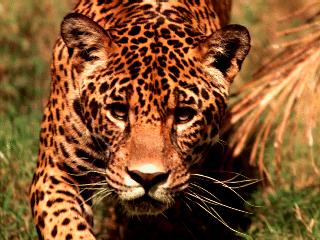
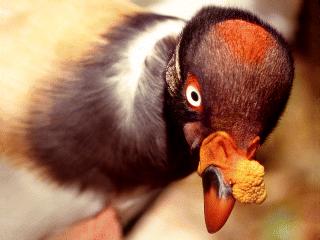
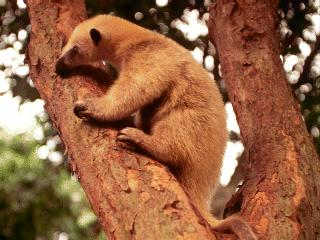

FAUNA IN EXTINCTION - BRAZILIAN MACAWS
PUASP-Postal Union of the Americas has defined for
1993 the theme "Fauna in Extinction" which came to meet the Brazilian Institute
of Environment and Renewable Resources-lBAMA's objective that is to divulge of
its own activities and those of other environmental organizations, as far as the
preservation of extinct/threatened Brazilian macaws is concerned.
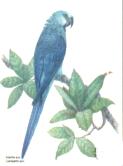 Ararinha-azul - Little blue macaw (Cyanopsitta
spixi)
Ararinha-azul - Little blue macaw (Cyanopsitta
spixi)
The little blue macaw (Cyanopsitta spixi) has become the more threatened species of birds in the world with a single wild macaw and around 30 other captive birds all over the world Its description on behalf of science in the middle of last century have been possible through a captive macaw trapped in northern Bahia, but the species has remained, for almost 150 years, untouched by any kind of study on its basic biology within nature.
The last surviving members of the species were spotted in 1985, in Melancia Creek, municipality of Curuçá, and have allowed the beginning of studies in nature. Regrettably, in the end of 1986, the actions' of bird smugglers resulted in the death of the last three survivors . The last one was found in 1990, in which the Brazilian Institute of Environment and Renewable Natural Resources has established the Committee for Recuperation of the Little Blue Macaw. The recuperation of a species so threatened as little blue macaw requires prompt and complex actions which aim to reverting the problem that can be solved by the utilization of renewable natural resources in concert with their own internal processes of recomposition.
The other stamp that belongs to that series represents three species of genus Anodorhynchus which main characteristics are described below:
 Arara-azul - Blue macaw (Anodorhynchus
leari)
Arara-azul - Blue macaw (Anodorhynchus
leari)
That species occurs in a region near little blue macaw's habitat. Although it can be found also in "caatingas" in the northern Bahia, that species occupies a different kind of "caatinga".
There are today approximately 60 macaws of that species, but until the 70's we did not know practically anything about them. Discovered by science in the last century, that genus of macaws has appeared from time to time in the live birds market in this century, but its origin is unknown.
It has never been a frequent product in that market and therefore we can only suppose that it was hunted by man as a source of food since there are no records about that activity as far as this kind of macaw is concerned.
Arara-azul - Blue macaw (Anodorhynchus glaucus)
Extinct, probably in the end of the last century, it was the first Brazilian bird to be ripped away from earth. Little is known about its wild life besides that it used to live on the rocky riverbanks of Paraná River where it probably nested, like the Anodorhynchus leari and other populations of Anodorhynchus hyacinthinus are used to do on northeastern steep cliffs.
Like the other two macaws of genus Anodorhynchus, it has a predominant blue color rather a dull grayish-blue different of the brilliant plumage of the Anodorhynchus hyacinthinus or of the body and tail of the Anodorhynchus leari.
Arara-azul - Blue macaw (Anodorhynchus hyacinthinus)
The largest of all macaws and the largest of all psittacidae family (which includes parrots, macaws, parakeets etc.) all over the world. It is the most widely distributed of the blue macaws. They occur along the Middle-West, part of Brazilian northeast, strips of southern Amazônia, and some go as far as the extreme northwestern Sao Paulo.
The blue macaw preservation is a very troublesome matter due to the pressure exerted on habitat by encroaching humans. Its former habitat has been extremely modified by deforestation, specially in the last 50 years. Losing environment means extinction of species in the places they occur. Simultaneously to that, there is the illegal trade of live birds carried out, not only within the country but also overseas, to where they are smuggled.
If there is no awakening of environmental consciousness both in Brazil and in foreign countries, the maintenance of this illegal market will result in the extinction, in few years, of the largest macaw living today on earth.
PAULO DE TARSO ZUQUIM ANTAS
Biologist Research
Center for Preservation of Wild Birds CEMAVE/IBAMA
FAUNA EM EXTINÇÃO - ARARAS BRASILEIRAS
Esta série foi iniciada em 1989, com denominação AMÉRICA, e já assinalou os seguintes temas sugeridos pela UPAEP - União Postal das Américas, Espanha e Portugal: Povos Précolombianos - Usos e Costumes (1989)- O Meio Natural visto pelos Descobridores (1990); As Viagens dos Descobrimentos (1991); e o V Centenário do Descobrimento da América (1992).
Continuando, a UPAEP definiu para 1993 o tema "Fauna em vias de extinção", fato que veio ao encontro dos objetivos do Instituto Brasileiro do Meio Ambiente e dos Recursos Naturais Renováveis, no sentido de divulgar suas ações e de outras organizações ambientais no que se refera à preservação das araras brasileiras extintas ou ameaçadas de extinção.
Ararinha-azul
(Cyanopsitta spixi)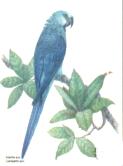
A Ararinha-azul (Cyanopsitta spixi) tornou-se a espécie de ave mais ameaçada de extinção do planeta com um único exemplar conhecido em liberdade e cerca de 30 em cativeiro, ao redor do globo. Descrita para a ciência em meados do século passado a partir de um exemplar coletado no norte do Estado da Bahia, essa espécie permaneceu durante quase 150 anos sem qualquer estudo de sua biologia básica na natureza.
A localização, em 1985, dos últimos sobreviventes da espécie no riacho Melancia, Município de Curuçá permitiu o inicio dos estudos na natureza. Infelizmente a ação de contrabandistas de aves fez com que dois dos três exemplares existentes desaparecessem no final de 1986. Em 1990 o exemplar restante foi relocalizado, no mesmo ano em que o Instituto Brasileiro de Meio Ambiente e dos Recursos Naturais Renováveis criava o Comitê para Recuperação da Ararinha-azul. A recuperação de uma espécie extremamente ameaçada como a Ararinha-azul obriga a ações rápidas e complexas visando reverter o problema, algo que pode ser contornado se forem utilizados os recursos naturais renováveis em harmonia com seus processos internos de recomposição.
O outro selo desta Série apresenta três espécies do gênero Anodorhynchus, cujas principais características são apresentadas a seguir:
Arara-azul (Anodorhynchus leari)
Esta espécie habita uma região próxima à área de ocorrência da Ararinha-azul. Embora também viva na região de caatingas do norte baiano, esta espécie ocupa um tipo diferente de caatinga.
Existem, hoje, cerca de 60 araras desta espécie na natureza. Conhecemos lá alguns detalhes sobre a vida desta espécie, mas até a década de 70 não sabíamos praticamente nada. Descoberta para a ciência no século passado, esta arara esporadicamente apareceu no comércio de aves vivas ao longo deste século, sem que sua origem fosse conhecida.
Nunca foi freqüente no comércio de animais vivos e somente poderemos especular uma caça pelo homem como alimento, já que não existem registros desta atividade sobre a arara.
Arara-azul (Anodorhynchus glaucus)
Extinta provavelmente no final do século passado, foi a primeira ave brasileira a desaparecer da face da terra. Pouco é conhecido de sua vida em liberdade, sabendo-se unicamente que vivia nos paredões rochosos do Rio Paraná, onde provavelmente nidificava, como faz nas barrancas do nordeste a arara Anodorhynchus leari e algumas populações de Anodorhynchus hyacinthinus.
Como as outras duas araras do gênero Anodorhynchus, possuía a cor azul como dominante, embora fosse um azul-acinzentado fosco, sem o brilho da plumagem de Anodorhynchus hyacinthinus ou do corpo e cauda de Anodorhynchus leari.
Arara-azul
(Anodorhynchus hyacinthinus)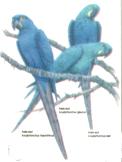
A maior de todas as araras e de toda a família dos psitacídeos (a que engloba papagaios, araras, periquitos e assemelhados) no mundo. Dentre as araras azuis, é a que possui distribuição geográfica mais ampla, ocupando no passado todo o Centro- oeste e parte do nordeste brasileiro, além de penetrar em faixas do sul da Amazônia, chegando ao extremo noroeste do Estado de São Paulo.
A situação de conservação da Arara-azul é bastante problemática devido à pressão humana. Sua antiga área de ocorrência foi extremamente alterada por desmatamentos, especialmente nos últimos 50 anos. A perda do ambiente significa a extinção da espécie nos locais onde ocorre. Ao mesmo tempo, há o comércio ilegal de aves vivas tanto no País quanto no exterior para onde são contrabandeadas.
Caso não haja uma firme tomada de consciência tanto internamente quanto no exterior, a manutenção deste mercado ilegal levará à extinção a maior Arara da face da terra em poucos anos.
PAULO DE TARSO ZUQUIM ANTAS
Biólogo Centro de
Pesquisas para a Conservaçãode Aves Silvestres
PRESERVATION OF THE FAUNA
Dynastes hercules
(Linnaeus, 1758) Coleoptera, Scarabaeldae, Dynastinae - hercules beetle
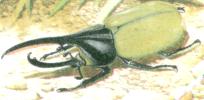
It belongs to the subfamily Dynastinae, family Scarabaeidae, which is represented in Brazil by ca. 1,800 species.
The Dynastinae are the largest known scarsabaeids and can measure over 150mm long . They display a conspicuous sexual dimorphism and males have projections, tubercles and horns on the head and the pronotum with generally extravagant shapes.
Dynastinae larvae, commonly known in Brazil as "pão-de-galinha" or "torresmo", feed upon roots or decayed vegetable matter inside the soil. Adults are attracted by light and - depending on climatic conditions - hundreds of them can be found around one single light source.
The genus Dynastes comprises four neotropical species. D. hercules - one of the greatest ones - can be found in the forest areas from Central America to Brazil (Bahia state) and in the Lesser Antilles. Adults live about six months and feed upon decayed fruits. Males - with huge horns - engage in spectacular battles and sometimes one of the contenders can be cut in the middle. Larvae live on decayed wood and the larval cycle lasts around 20 months.
Batus barbicornis
(Linnaeus, 1764)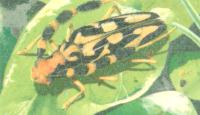
Coleoptera Cerambycidae - Wood-boring beetle or "long-horned"
This species belongs to the family Cerambycidae which joins about 10,000 species in Americas. Besides B. barbicornis, the genus Batus comprises two other species which appear in the Amazonian and Atlantic forests. B. barbicornis habitat is Hylea. Host plants and ontogenetic development are still unknown.
Usually Cerambycidae larvae feed upon wood and dig galleries inside trunks and branches. This feeding behavior causes serious injuries or even the death of the host plants.
Adults have generally a short life; they die some days after the copulation and the egg-laying, after the emergence. On the other hand larval life is long, usually one year, but it can be extended to two or three years.
If, on one hand, the Cerambycidae larvae are injurious to forest and ornamental species and to fruit trees, on the other, they are very important agents in the recycling of nutrients. By getting their food from fallen branches and trunks they enable - through the galleries - the entrance of cellulolytic fungi and bacteria which cause acceleration of vegetable matter decomposition.
UBIRAJARA R. MARTINS Zoology Museum
University of
São Paulo Brazilian Society of Entomology
PRESERVAÇÃO DA FAUNA
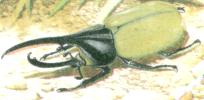 Dynastes hercules(Linnaeus,
1758)
Dynastes hercules(Linnaeus,
1758)
Coleoptera, Scarabaeidae, Dynastinae-"besouro-hercules".
Pertencente
à subfamília Dynastinae da família Scarabaeidae que está representada no Brasil
por ca. 1.800 espécies.
Os Dynastinae são os maiores escarabeídeos conhecidos e podem ultrapassar 150 mm de comprimento. Apresentam acentuado dimorfismo sexual e os machos ostentam na cabeça e no pronoto projeções, cornos e protuberâncias com formas geralmente extravagantes.
Larvas de Dynastinae, vulgarmente conhecidas como "pão-de-galinha" ou "torresmo", alimentam-se de raízes ou matéria vegetal em decomposição no interior do solo. Os adultos são atraídos à luz e, dependendo das condições climáticas, centenas deles podem ser atraidos a uma fonte luminosa.
O gênero Dynastes congrega quatro espécies neotropicais. D. hercules uma das maiores ocorre nas áreas florestais da América Central ao Brasil (Bahia) e nas Pequenas Antilhas. A vida dos adultos dura aproximadamente seis meses; alimentam-se de frutos em decomposição. Os machos com suas pinças enormes travam batalhas espetaculares e, às vezes, um dos contendores pode ser secionado ao meio. As larvas nutrem-se de madeira em decomposição e a duração do estágio larval é de cerca de 20 meses.
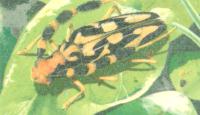 Batus barbicornis ( Linnaeus, 1764)
Coleoptera, Cerambycidae- "toca-viola" ou "serra-pau".
Batus barbicornis ( Linnaeus, 1764)
Coleoptera, Cerambycidae- "toca-viola" ou "serra-pau".
Espécie integrante da família Cerambycidae que reúne cerca de 10.000 espécies nas Américas. O gênero Batus, além de B. barbicornis, contém outras duas espécies que ocorrem nas florestas Amazônica e Atlântica. B. barbicomis habita a Hiléia e suas plantas-hospedeiras e desenvolvimento ontogenético são ainda desconhecidos.
De maneira geral, as larvas de Cerambycidae alimentam-se de madeira e escavam galerias no interior de troncos e ramos. Esse comportamento alimentar determina sérias injúrias ou até mesmo a morte das plantas-hospedeiras.
Os adultos normalmente têm vida efêmera; perecem pouco tempo após a cúpula e a postura, que podem ocorrer alguns dias depois da emergê!ncia. Em contraposição, a vida larval é longa, quase sempre de um ano, podendo prolongar-se a dois ou três.
Se por um lado daninhas às essências florestais e ornamentais e às árvores frutíferas, as larvas de Cerambycidae desempenham papel relevante na reciclagem de nutrientes. Ao se alimentarem nos ramos e troncos caldos viabilizam através de suas galerias a entrada de fungos e bactérias celúloliticos que determinam aceleração na decomposição da matéria vegetal.
Ubirajara R. Martins
- Museu de Zoologia
Universidade de São Paulo Sociedade Brasileira de Entomologia
PRESERVATION OF FAUNA
"Mico-leão-dourado" 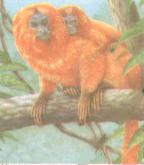 (Leontopithecus
rosalia—Linnaeus 1766) The "mico-leão-dourado" (Leontopithecus rosalia) is
worldwide known as a symbol of nature conservation in Brazil. That small primate
has approximately 25 to 35cm of height, the tail is 30 to 40cm long, and he
weighs around 600g. The fur has the color of fire and the shade varies along the
body. On the head he carries a mane which is likely to have given him his
name.
(Leontopithecus
rosalia—Linnaeus 1766) The "mico-leão-dourado" (Leontopithecus rosalia) is
worldwide known as a symbol of nature conservation in Brazil. That small primate
has approximately 25 to 35cm of height, the tail is 30 to 40cm long, and he
weighs around 600g. The fur has the color of fire and the shade varies along the
body. On the head he carries a mane which is likely to have given him his
name.
Besides their unusual beauty that caught the smugglers' attention, the forests destruction has been the main reason for their extinction. Today the woods that constitute the "micoleão-dourado" habitat are limited to small islands in the Atlantic Forest, in the State of Rio de Janeiro.
Protected by Federal Law No. 5.197, of January 3, 1967— "law of Fauna", he is also included in the official list of Brazilian fauna's endangered species. Regulation No. 1.522, of December 19, 1989—IBAMA, and are also covered by the International Committee that is in charge of the program of recuperation and management of the species that aims at establishing a population genetically sustainable.
The program of conservation for the species has begun in the 70's through the agreement between the Brazilian Institute of Environment and Renewable Natural Resources - IBAMA, the Rio de Janeiro Center of Primatology—CPRJ and the National Zoological Park/Smithsonian Institution. Today that agreement between the three institutions became an interdisciplinary and international effort in order to preserve that species and its habitat, assuring its survival through conservation, education and researches activities.
MARIA IOLITA BAMPI—Veterinary ROSEMARY DE CARVALHO MAMEDE Zootechnician Brazilian Institute of Environment and Reriewable Natural Resources—IBAMA
"Sauim-de-coleira" (Saguinus bicolor)
The "sauim-de- coleira" (Saguinus bicolor) of the
family Callitrichidae that includes the 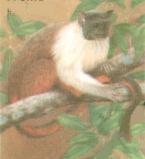 neotropical primates
of small stature, has 117 to 336mm of height, weighing 125 to 583g dental
formula 2i, 1c, 3pm, 2m, claws-like nails (except the thumb), and gives birth to
one or two babies (false twins), once or twice a year.
neotropical primates
of small stature, has 117 to 336mm of height, weighing 125 to 583g dental
formula 2i, 1c, 3pm, 2m, claws-like nails (except the thumb), and gives birth to
one or two babies (false twins), once or twice a year.
The "sauim-de-coleira" is the only callitrichideous specimen living in Manaus region. Its distribution extends to east up to
Itacoatiara city and 40km to the north of Manaus. Due to the restricted distribution and to the few data available in the literature about its biology and ecology, it has been included in the national and international lists of endangered species.
Available information say that the "sauim-de-coleira" feeds on insects and fruits, nectar and saps, lives in groups of around 10, in an area of 12 to 21 ha, and gives birth to two babies, twice a year.
The protection of green areas around Manaus and peripheral region, and campaigns for environmental education led with the local population stressing its importance for the Amazon biodiversity patrimony, improved planning, maintenance and supervision of the huge governmental projects for the development of the region, and more studies about their biology and ecology are primary concerns for the preservation of the subspecies.
SILVIA GONSALVES EGLER—Biologist Coordination of Researches in Ecology/CPEC National Institute of Researches in Amazon/NPA
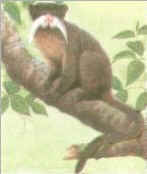 "Macaco-bigodeiro" (Saguinus imperator—Goeldi,
1907)
"Macaco-bigodeiro" (Saguinus imperator—Goeldi,
1907)
The genus Saguinus, commonly known as "saguis" or "soins", belongs to the family Callitrichidae, of the primate order. Characteristically they are small.
It is the most diversified genus among the neotropical primates, containing 11 species and more than 30 recognized subspecies. In Brazil they are distributed all over the tropical forests of the region north of Amazon River, and in the south they are restricted to the regions situated between Xingu River and Gurupi River, and to the west of Madeira River.
The saguinus imperator distinguishes from the other species by their mustache extremely long to which they owe their popular name. They have two subspecies, S. i. imperator (represented on the stamp) and the S. i. subgrisescens.
Diurnal and arboreal they live in groups of 3 to 8 individuals that weigh as adult around 400 to 500g. They feed mainly on fruits, insects and nectar. They look for their catches specially on leaves and lianes, but branches and tree holes are also inspected with less frequency.
In Brazil, they occur in primary and secondary forests in the State of Acre and southwest of Amazon. Mentioned on the official list of Brazilian fauna's endangered species, they are protected at federal level in the Acre River Ecological Station.
CLAUDIA CALEGARO-MARQUES JÚLIO CÉSAR BICCA-MARQUES MAURICILIA RODRIGUES DE SOUZA Institute of Environment of Acre State Federal University of Acre State
PRESERVAÇÃO DA FAUNA
Mico-leão-dourado (Leontopithecus rosalia—Linnaeus 1766) O mico-leão-dourado (Leontopithecus rosalia) é conhecido em todo o mundo como símbolo da conservação da natureza no Brasil. Este primata de pequeno porte mede aproximadamente de 25 a 35cm, tem cauda de 30 a 40cm e pesa em torno de 600g. A pelagem tem a cor de fogo, variando a tonalidade ao longo do corpo. Na cabeça ostenta uma espécie de juba, a qual deve lhe ter valido a denominação.
Além da rara beleza que chamava a atenção dos contrabandistas, a destruição das matas foi a razão principal do seu desaparecimento, sendo que as que ainda hoje constituem o habitat do mico-leão-dourado estão confinadas a pequenas ilhas da Mata Atlânticas no Estado do Rio de Janeiro.
Protegido pela Lei Federal n° 5.197, de 3 de janeiro de 1967 —"Lei de Fauna", está também incluído na "lista of icial de espécies da fauna brasileira ameaçadas de extinção", portaria N° 1.522, de 19 de dezembro de 1989—IBAMA, além de contar com o Comitê Internacional que trata do programa de recuperação e manejo da espécie, objetivando alcançar o estabelecimento de uma população geneticamente sustentável.
O programa de conservação para a espécie teve início nos anos 70 por meio da colaboração entre o Instituto Brasileiro do Meio Ambiente e dos Recursos Naturais Renováveis—IBAMA o Centro de Primatologia do Rio de Janeiro CPRJ e o National Zoological Park / Smithsonian Institution, sendo que, hoje, o compromisso entre essas entidades transformou-se num esforço interdisciplinar e internacional para preservar esta espécie e seu habitat, a fim de assegurar sua sobrevivência por meio de atividades de conservação, educação e pesquisa.
MARIA IOLITA BAMPI—Veterinária ROSEMARY DE CARVALHO MAMEDE—Zootecnista Instituto Brasileiro do Meio Ambiente e dos Recursos Naturais Renováveis—IBAMA
Sauim-de-coleira (Saguinus bicolor)
O sauim-de-coleira (Saguinus bicolor} pertence à Família Callitrichidae, que compreende os primatas neotropicais de tamanho pequeno (117 a 336mm), com peso de 125 a 583g, fórmula dentária 2i, 1c, 3pm, 2m, unhas em forma de garra (exceto o polegar), com parição de um a dois filhotes (gêmeos falsos) uma ou duas vezes ao ano.
O sauim-de-coleira é o único calitriquídeo na região de Manaus. Sua distribuição se estende a leste, chegando até a cidade de Itacoatiara, e a cerca de 40km ao norte de Manaus. Devido
a esta distribuição restrita e aos poucos dados disponíveis na literatura sobre sua biologia e ecologia, foi incluido nas listas nacionais e internacionais de espécies ameaçadas de extinção.
As informações disponíveis indicam que o sauim-de-coleira é insetívoro-frugivoro (se alimentando de insetos, frutos, néctar e exsudados de árvores), vive em grupos com cerca de 10 indivíduos em uma área de 12 a 21 ha e pare dois filhotes duas vezes ao ano.
A proteção de áreas verdes na região de Manaus e arredores; campanhas de educação ambiental realizadas junto à população local sobre sua importância como patrimônio da biodiversidade amazônica; melhor planejamento, manutenção e supervisão dos grandes projetos governamentais de desenvolvimento para a região; e mais estudos sobre sua biologia e ecologia são fatores primordiais para a preservação da subespécie.
SILVIA GONÇALVES EGLER—Bióloga Coordenação de Pesquisas em Ecologia / CPEC Instituto Nacional de Pesquisas da Amazônia / INPA
Macaco-bigodeiro (Saguinus imperator—Goeldi, 1907)
Os representantes do gênero Saguinus, conhecidos popularmente por sagüis ou soins, pertencem à Família Callitrichidae, Ordem Primates. Possuem um tamanho pequeno, característico da família.
É o gênero de maior diversidade dentre os primatas neotropicais, possuindo 11 espécies e mais de ão subespécies reconhecidas. No Brasil distribui-se nas florestas tropicais de toda a região ao norte do Rio Amazonas, estando, ao sul deste rio, confinado às regiões localizadas entre os baixos Rio Xingu e Rio Gurupi e oeste do Rio Madeira.
O Saguinus imperator distingue-se das demais espécies do gênero pela presença de um bigode extraordinariamente longo, o qual lhe valeu o nome popular de sagüi-bigodeiro. Possui duas subespécies, S. i. imperator (representado no selo) e S. i. subgrisescens.
Diurno e arborícola, vive em grupos compostos por três a oito indivíduos, os quais pesam, quando adultos, aproximadamente 400 a 500g. Alimenta-se, principalmente, de frutos, insetos e néctar. Procura suas presas, principalmente, em folhas de árvores e cipós. Galhos e ocos de árvores também são inspecionados, porém com uma freqüência muito menor.
No Brasil ocorre em florestas primárias e secundárias dos Estados do Acre e sudoeste do Amazonas. Citado na lista of icial de espécies da fauna brasileira ameaçadas de extinção, encontra-se protegido, a nível federal, na Estação Ecológica Rio Acre.
CLÁUDIA CALEGARO-MARQUES JÚLIO CÉSAR BICCA-MARQUES MAURICiLIA RODRIGUES DE SOUZA Instituto de Meio Ambiente do Acre e Universidade Federal do Acre
PRESERVATION OF FAUNA
MACUCO (Enamus solitarius)
The Tinamidae resemble the gallinaceous but their resemblance with the Galiformes is considered a result of a convergence or a parallel evolution. The Tinamidae family is very important for omithology, endemical at the Neotropics and belonging to the oldest avifauna of the South American continent.
In spite of their synergetic characteristics, they get tired easily when flushed. This deficiency is due to the ill-irrigated tissues, consequence of the blood vessels diameter in the breast muscles. That characteristic produces a white-greenish color in the spedes' meat which is so loose that it rips open under the slightest impact.
The "macuco" (Tinamus solitarius) is the largest of the southern representatives of the Tinamidae family. Their average size is 52cm, the male weighs 1.2009 to 1.5009 and the female 1.3009 to 1.8009. Their dark-olive back and light gray belly are unmistakable.
They prefer cleaner woods but can be found also in irregular areas such as creeks, caves and places of difficult access. They occur in a vast area, spreading all over the forest regions of eastern Brazil, from Pernambuco to Rio Grande do Sul, including Minas Gerais, south of Goiás and southeast of Mato Grosso. They are found also in Paraguay and Argentina. Among their natural predators are the "gato-do-mato" the fox the "guaxinins", the "furões", the opossums and "iraras" besides the hawks and owls. Snakes, monkeys and other carnivorous animals may attack their nests. The "macuco" is one of the most hunted gamebirds of Brazil.
PAULO HENRIQUE CHAVES CORDEIRO Biologist
MUTUM-DE-ALAGOAS (Mitu mitu)
Slightly larger than a domestic rooster it has black plumage, light brown belly; the tail's two central feathers are uniformly blacksand the others have light brown spots in the white extremities; dark-blue lustrous wings; velvet-like feathers cover head and neck, in larger quantity on the head diminishing the volume down to the neck. They have down-curved bills with light-pink extremity and redder culmen. A characteristic of the species is the unfettered ear region. The pallid light-pink tarsi and fingers with dark-gray nails resemble those of the chickens. The eyes are dark-brown with discreet red hues.
Their geographic distribution is very restricted. References of their original habitat are linked to the State of Alagoas, in part of the Atlantic forest known as open rain forest and in lowland forests particularly in Marechal Deodoro, Barra de São Miguel and Roteiro de São Miguel dos Campos.
Due to the failures of the latest omithological expeditions that could not register the presence of the "mutum-de-alagoas" in the remaining areas that used to be its habitat, this species was considered in extinction in nature.
MAURICIO CERQUEIRA DE ARAUJO Agronomic Engineer IBAMA- Brazilian Institute of Environment and Renewable Natural Resources / AL
PRESERVAÇÃO DA FAUNA
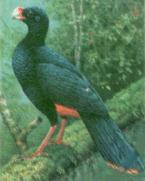 MACUCO (Tinamus
solitarius)
MACUCO (Tinamus
solitarius)
Os Tinamideos possuem uma aparência galinácea, porém sua semelhança com os Galiformes é considerada como efeito de uma convergência ou evolução paralela. A Familia Tinamidae é muito significativa para a ornitologia sendo endêmica do Neotrópico e pertencendo à avifauna mais antiga do continente Sul-americano.
Apesar de suas características cinegéticas, quando per seguidos cansam-se rapidamente Tal deficiência se deve à irrigação prejudicada dos tecidos, isso pelo diametro dos vasos sanguineos nos músculos peitorais, responsáveis pelo vôo. Essa caracteristica também dá uma coloração branca-esverdeada à carne dos tinamídeos, sendo essa tão frouxa que se desfaz ante o menor impacto.
O macuco (Enamussolitarius) é o maior dos representantes meridionais da familia Tinamidae com 52cm e peso entre 1.200g a 1.500g para os machos e 1.3009 a 1.8009 para as fêmeas. Ave inconfundível pela coloração do dorso pardo azeitonado e ventre cinza-claro.
Apesar de gostarem de matas mais limpas ocorrem também em áreas acidentadas como córregos, grotas e locais de dificil acesso. Sua área de ocorrência é vasta e a espécie se distribui por todas as regiões florestadas do Brasil Oriental, indo de Pernambuco ao Rio Grande do Sul, incluindo Minas Gerais, Sul de Goiás e Sudeste de Mato Grosso. Ocorre também no Paraguai e Argentina.
Dentre seus predadores naturais estão o gato-do-mato, a raposa, os guaxinins, furões, gambáse iraras, além dos gaviões e corujas. Também os ninhos podem $ser saqueados por cobras, macacos e outros carnívoros.
O macuco está entre as mais procuradas aves de caça do Brasil.
MUTUM-DE-ALAGOAS (Mitu
mitu)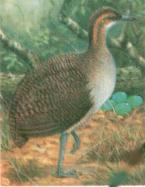
Ave de tamanho pouco maior que o de um galo doméstico, de plumagem . negra em seu dorso, ventre marrom-claro, tendo as duas penas centrais da cauda uniformemente negras e as demais com pontas brancas, manchadas de marrom-claro. As asas possuem lustro azul-escuro. A cabeça e o pescoço apresentam penas com aspecto aveludado, mais avolumadas no sentido da cabeça para o pescoço. Seu bico apresenta aspecto curvo, de extremidade rosa-clara e parte mais interna (cúlmem) de coloração vermelha. Um detalhe para a espécie é a região do ouvido, desprovida de penas. Os tarsos e dedos são semelhantes aos da galinha, de pálida coloração rosa-clara com unhas de cor cinza-escura. Os olhos são castanho-escuros, com tons vermelhos discretos.
Sua distribuição geografica é bastante restrita, encontrando-se referências ao seu habitat original ligado ao estado de Alagoas em parte da Mata Atlântica na tipologia conhecida como floresta Ombrófila Aberta e nas matas de baixadas, particularmente nos municípios de Marechal Deodoro, Barra de São Miguel e Roteiro de São Miguel dos Campos.
Em virtude dos insucessos das últimas expedições omitológicas, não havendo mais nenhum registro comprovado nos poucos fragmentos florestais remanescentes do seu habitat, considerou-se corno uma espécie em extinção na natureza.
MAURICIO CERQUEIRA DE ARAUJO Eng° Agrônomo IBAMA - Instituto Brasileiro do Meio Ambiente e Recursos Naturais Renováveis / AL
Designed and
maintained by FLB Enterprises
![]()